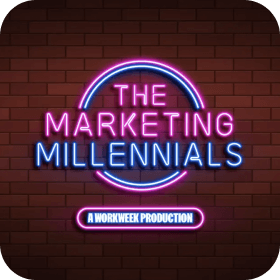You might be able to feel it through the energy of this newsletter, but I am SO EXCITED for today’s guest. 🤪🤪
I was at a mastermind a few months ago and today’s guest was there on stage and legit I think I could listen to her talk Marketing ALL DAY.
(And guess whatttt??!) We have her HERE today to talk about if growth loops ACTUALLY WORK.
Marketing Bestie, meet Eva Thouvenot, formerly the Senior Director of Marketing at Bench Accounting, VP of Marketing at Bonsai, and the current VP of Sales & Marketing at Regen, Eva has an unparalled Marketing resume.
Some might call her a Marketing savant (and by some I mean ME).
Here’s what Eva had to say on The Marketing Millennials Podcast, in her own liiiiightly edited words.
1. Growth Loops vs. Funnels:
“The distinction between growth loops and funnels, is the focus on growth.
And to be clear, growth being acquisition, monetization and retention. (YES.) Think of your growth as a system.
How do you acquire a user? How do you monetize users? How do you retain them? And how does that compound into reinvesting that money or that capital into more acquisition.
With a funnel, which is very linear, you always have to invest more at the top. If you want more customers at the bottom, then you need more money at the top, so at the end of the funnel you have more customers. (I’m a funnel fan so I’ll have to hear Eva out on this one!)
The loop concept challenges the funnel by being able to find efficiencies in circularity that accelerates growth, not just through adding more capital.
Here’s an example of a typical SEO loop vs. an SEO funnel: Create content, distribute that content, get traffic, convert that traffic, make money, reinvest the money in scaling content distribution.
The loop starts by creating content, then you obviously want that content to rank on Google.
Once you’ve created the content and its ranking, then you have a certain amount of conversion into your MQL, and then some will turn into customers.
Those customers will then generate revenue that you can then reinvest in creating additional content. (AHHH I get it. Looks like I’m a growth loop fan too LOL.)
2. Improve This Part of Your Funnel:
What part of your existing funnel/loops should you look at improving? Great question.
Level up your marketing game
Zero BS. Just fun, unfiltered, industry insights with the game-changers behind some of the coolest companies from around the globe.
No spam. Unsubscribe any time.
Here’s a map of what a growth system would look like:
What channels are being used right now? What is the average sales per customer, ASB or LTV? How long do you retain customers? How fast can you reinvest that money into acquisition? (FANTASTIC questions.)
After having all of that info, I will zoom into the biggest growth constraint.
For example let’s say it’s not being able to scale content distribution, or you don’t have enough money to create more content. Okay, is it a matter of execution or do you not have the right team? 👀👀👀
Wherever the growth constraint is, do you feel confident that you can move that constraint? Hopefully yes, because it’s easier to move a constraint from a loop that you’ve already built than to launch a brand new growth loop.
Always start by looking at the low hanging fruit you can grab to accelerate growth for your already existing loops.
3. 10x your Marketing Impact:
A lot of Marketers stop at only optimizing for the top of funnel, instead of looking holistically at the goals of the funnel or growth loops.
If you simply are aware of the holistic approach that will make you 10x more impactful as a Marketer (retweeeettttt).
Tangibly speaking, one example that I have around that theory was when I was at Bench Accounting…
We realized what prevented us from growing as a company was not conversion rates from traffic to opportunity on the ads loop, it was churning because we weren’t able to reinvest fast enough.
When you use a loop system, if you have less money to invest in acquisition, then it’s either a matter of their churning (OR they’re not spending enough money.)
So if your biggest constraint as a company is churn, there’s some big decisions that need to be made at the company level in product.
But the reality is we as Marketers probably don’t control that.
So what do you do to help with churn? Better targeted ICP (MHMMM). Dissect the current data, is one type of ICP churning 50% less than the others?
Because you most likely don’t control product decisions, your focus should be on finding solutions on how you acquire that type of customer to fuel your loop, increase retention, and make the whole acquisition more efficient?
The model in the loop system is the framework to think, but it’s what you do after that has the most impact.
4. Using Growth Loops to Get More Budget:
Say today you have a 2% conversion from traffic to MQL, (just shooting random numbers) and you think you can get it to 5%. That would be a MASSIVE bump.
What does that look like when you make this change on your growth trajectory? You can model it, keep all other variables equal, move the one variable in your growth loop from 2 to 5%, how much more MRR would you generate?
The greatness of the system is being able to identify the opportunity that will add the most value and growth for your organization (#efficiency).
That opportunity that will add most value isn’t opinion based, it should be data based and focused on the systems or holistic view that you have.
If the opportunity that will add most value is investing in conversion and you can prove it, you’ll immediately get buy-in because it’s a no brainer (and we LOVE buy-in).
Such an efficient way to get resources and support as opposed to scrambling and doing a bunch of tactics across a variety of different touch points and then you’re not hitting a home run anywhere.
5. The Model of Building a Growth Loop:
Even before modeling growth constraints, what is your winning aspiration for next year? Is it growth in terms of ARR? Is it MRR? Is it number of customers? What are you optimizing for?
These questions will all have an impact on the choices you’re making as a Marketer (and regardless of building growth loops these are questions you NEED to be answering).
So for example 50% growth in MRR is the goal, my second step would be identifying those growth constraints we’ve been talking about.
The third step is addressing the incredibly simple question of, “Can we win convincingly for our audience?” (This is WHO you can convincingly create value for.)
How are you going to win?
And then you want to target those folks because you know you can create the most value for them.
Now you have this context, you have this framework, then you can generate a set of who you want.
At the beginning I like to have a more open process, what are the things you could be doing to address those 4 or 5 biggest growth constraints? The handful that could have a drastically outsized impact on growth.
Launch TikTok ads, launch a reseller partner program, or double down on web conversion optimization. Whatever the growth constraint is, you have your set of possibilities and test those possibilities against a few different factors.
Like what are your core capabilities? Do you even have the resources to execute against that initiative?
Have 3-5, depending on the size of your team and organization possibilities that could be real that are tied to your audience, your growth constraints, AND your ultimate goal (SLAY).
From there ask the one killer question, “What would have to be true for this initiative to be the best possible choice for us?”
Then the team should map all the constraints and things that could go awfully wrong.”


